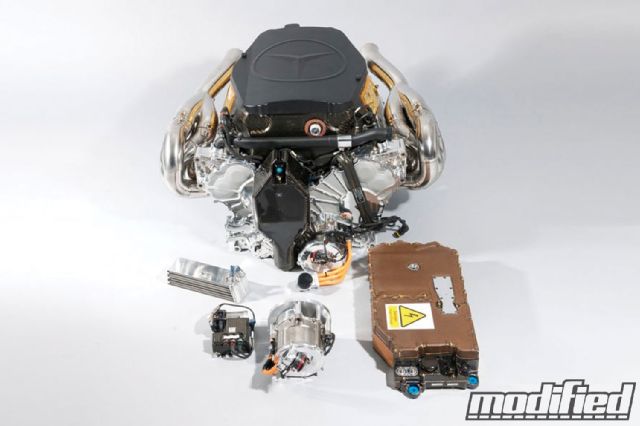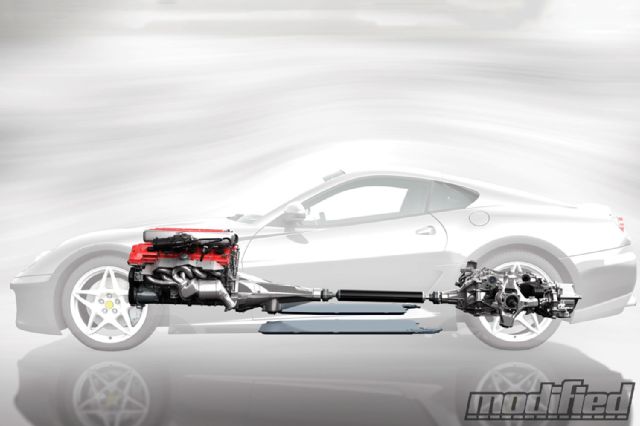 | The McLaren-Mercedes KERS setup is a typical F1 design, using a high-voltage battery pack (bottom right), an electric motor-generator (bottom middle), and the control unit (bottom left).
| The McLaren-Mercedes KERS setup is a typical F1 design, using a high-voltage battery pack (bottom right), an electric motor-generator (bottom middle), and the control unit (bottom left).
It’s probably not terribly surprising to hear that I’m not a big fan of the appliance-like hybrids that litter the HOV lanes of the world. Don’t get me wrong, I love Mother Earth as much as the next guy, but from my perspective the math has never added up on electric cars or even hybrids. As far as I can tell, the true cost to produce these types of vehicles and the cost to buy them is such that there’s no real savings for the owners (at least not over the first few years of ownership), plus they do little to reduce your carbon footprint once you factor in the manufacturing processes involved (you know, because making and disposing of batteries is a dirty business). About the only redeeming quality I can find in most hybrid and electric vehicles is that they’re useful testbeds for future technologies that will result in EVs and HEVs that don’t suck.
And by not sucking I mean fast and fun to drive, and in that regard there have been some exciting developments as it relates to the use of electric motors, battery packs, and kinetic energy recovery systems (KERS) on the world’s latest batch of hypercars, namely the Porsche 918 Spyder, the Ferrari LaFerrari (worst…name…ever!), and the McLaren P1. All three of these mega-dollar speed machines are equipped with massively powerful combustion engines, but they also have electric motors onboard to provide even more performance and at least a whiff of eco-friendliness.
You can, in fact, drive the Porsche and the McLaren in full electric mode (though not particularly quickly), and with their KERS regenerative braking systems, the batteries for the electric motors can be recharged with the brake pedal, not just the outlet in your garage. OK, not your garage, but some oil sheik’s garage. Talk about ironic. In any case, the point of these new hypercars isn’t to drive them around in e-mode; it’s to use the extra go-juice provided by the electric motors to go faster. Personally, I like Ferrari’s approach, where they don’t pretend the LaFerrari is an electric car and thus provide no electric-only mode. Instead, they use their F1-derived KERS system for a 161hp boost in power, plus they’ve designed it to deliver its e-torque down low in the rpm range so the V12 gas engine can focus more on high-rpm performance (9,250 rpm, anyone?).
Of course, it’s all well and good to see mega-dollar hypercars using electric motors and KERS to boost performance and reduce their massive carbon footprints a little, but what about us regular Joes? Will we start to see this more performance-oriented use of electric-hybrid technologies on cars we can actually afford? If you believe the rumor mill, the answer is yes. But before getting to that, let’s take a quick look at how KERS works, and why it’s an exciting technology for go-fast geeks like you and me.
KERS is actually a trickle-down technology from Formula 1, the idea behind it being that it would encourage passing by giving drivers an 80hp boost in power for just under 7 seconds a lap, which they could use at their discretion. Plus, F1 wanted to be seen as promoting the development of environmentally friendly and road car–relevant technologies.
 | This view of a front-axle KERS system shows you how the electric motor-generator (3) is linked to the transmission and clutch (1 and 2) as well as the control unit (4).
| This view of a front-axle KERS system shows you how the electric motor-generator (3) is linked to the transmission and clutch (1 and 2) as well as the control unit (4).
There are three approaches to KERS, the most popular being the use of batteries as the storage reservoir for the kinetic energy harnessed from the braking system, but there are also mechanical versions in which a small flywheel is used to store the energy as well as hydraulic systems in which pressure buildup is the storage approach.
Regardless of the storage system, all KERS systems are based on the recovery of energy by linking an electric motor-generator to the brakes such that it’s used to slow the car at first. When the driver lifts off the throttle, the electric motor’s resistance to spinning slows the car (the traditional braking system doing the rest of the braking), plus the e-motor’s spinning acts as a generator that recovers the rotational kinetic energy at the wheels.
Most F1 KERS systems to date have opted for high-voltage lithium-ion battery storage, the other major components to the system being an electric motor-generator that links the engine and braking systems and a CPU that monitored the charging and release of this energy. Magneti Marelli, for example, the company that developed Ferrari’s F1 system, uses a driveshaft to connect the electric motor-generator to the brakes and the engine. Under braking, the driveshaft spins the electric motor and charges the batteries, and then under acceleration, the driveshaft spins the opposite direction and sends the battery-stored energy back through the electric motor to the combustion engine.
 | Here you can see how the Ferrari 599 HY-KERS model has its electric motor-generator mated to the rear of its dual-clutch seven-speed transaxle. It operates through one of the transmission’s two clutches and engages one of the two gearbox primary shafts, coupling power seamlessly and instantly between the electric motor and the V12.
| Here you can see how the Ferrari 599 HY-KERS model has its electric motor-generator mated to the rear of its dual-clutch seven-speed transaxle. It operates through one of the transmission’s two clutches and engages one of the two gearbox primary shafts, coupling power seamlessly and instantly between the electric motor and the V12.
In F1, the electric power has to be sent to the rear wheels in equal proportions, but on road cars there are no such limitations. So the new Porsche 918 Spyder, for example, has two electric motors onboard, a 154hp motor that drives the rear wheels in parallel with the engine and also serves as the main generator, and a 125hp motor that directly drives the front axle (an electric clutch decouples the front motor when it’s not in use). So as you can see, there are a lot of creative ways a KERS system can be used on road cars, the Porsche 918 in effect becoming an AWD machine when the front electric motors kick in. How cool is that?
Speaking of cool, one of the biggest issues with electric KERS systems is that the lithium-ion batteries get seriously hot. As a solution to this problem, BMW and Toyota have both used super-capacitors instead of batteries, Toyota using these in its ’12 Le Mans Prototype race cars that beat the Audi R18 e-Tron late last season.
Which brings me to one of the more intriguing rumors of 2012: Toyota GT86 chief engineer Tetsuya Tada implied the car might be getting a KERS system to boost engine output. Tada was quoted as saying, “I think 300 bhp with a turbo and 200 g/km of CO2 would be tasteless in this day and age. And a turbo would mean the loss of the GT86’s uniqueness. We’re looking for a surprise, something unique. For example, a next-generation hybrid…more like the TS030 Le Mans Prototype. We’re looking into that possibility.”
In fact, Toyota does have a KERS-equipped GT86 prototype up and running, but details about its system and performance are still unknown. Tada did say this, though: “Toyota wants to make things accessible. The [super-]capacitor is appropriate technology, but it’s not as lightweight as you might think, and it’s expensive.” This would imply a battery pack instead of a super-capacitor, and Tada did go on to say that the electronics industry is advancing at a great rate, further implying that a battery storage unit is likely the approach the company will take. With Toyota announcing that it will unveil its Hybrid R concept at the ’13 Frankfurt Auto Show, designed to “bring Toyota Hybrid System-Racing technology to the road,” more info on their approach should be available by the time you read this.
 | Rumor has it a KERS-equipped Toyota GT86/Scion FR-S will have a system similar to this one, from its Le Mans LMP1 race car.
| Rumor has it a KERS-equipped Toyota GT86/Scion FR-S will have a system similar to this one, from its Le Mans LMP1 race car.
For those of you thinking that a KERS system with batteries will add a ton of weight to the FR-S and kill its amazing handling dynamics, I wouldn’t lose any sleep over it. The 80hp F1 electric KERS systems only weigh about 75 pounds, and with the ability to mount the batteries low and centralized in the chassis (presumably under the rear seats or below the floorpan), the overall effect should be negligible.
It may not be the traditional approach of more revs and compression (which the FA20 is already pretty well maxed out on) or adding forced induction (which Toyota clearly sees as a less environmentally friendly approach), but you have to admit that using a KERS system to boost performance on a car like the GT86/FR-S/BRZ is an intriguing and compelling idea.
I guess the real question is, how far off is a KERS-equipped FR-S and how much of a price premium is it going to come with? If any carmaker can afford to subsidize this technology as a way of promoting a greener go-fast solution, it’s Toyota. And since it already owns 80 percent of the hybrid market, adding a performance-oriented hybrid variant would only further demonstrate Toyota’s mastery of this type of technology. As long as the price is right, a hybrid FR-S would give enthusiasts who want to go faster a viable and guilt-free alternative to forced induction.
